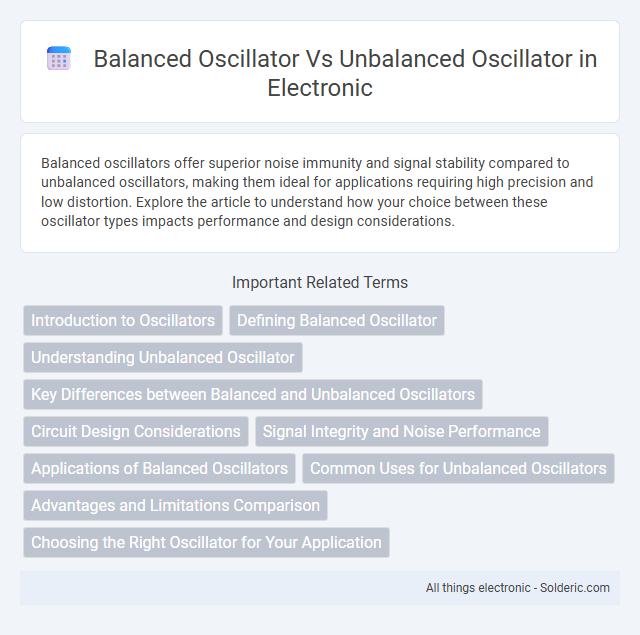Balanced oscillators offer superior noise immunity and signal stability compared to unbalanced oscillators, making them ideal for applications requiring high precision and low distortion. Explore the article to understand how your choice between these oscillator types impacts performance and design considerations.
Comparison Table
| Feature | Balanced Oscillator | Unbalanced Oscillator |
|---|---|---|
| Signal Output | Two equal and opposite signals (differential output) | Single-ended signal output |
| Noise Rejection | High; cancels common-mode noise | Low; susceptible to noise |
| Harmonic Distortion | Lower distortion due to symmetry | Higher distortion |
| Power Consumption | Typically higher due to dual paths | Lower power |
| Implementation Complexity | More complex; requires matched components | Simpler design |
| Applications | High-performance RF circuits, communication systems | General purpose, low-cost oscillators |
Introduction to Oscillators
Oscillators generate periodic signals crucial for electronic circuits, with balanced and unbalanced oscillators differing in configuration and stability. Balanced oscillators use symmetrical components to reduce distortion and improve signal purity, making them ideal for high-frequency applications. Your choice depends on desired signal quality and circuit complexity, with balanced oscillators offering enhanced performance in precise frequency generation.
Defining Balanced Oscillator
A balanced oscillator features two symmetrical signal paths that produce outputs with equal amplitude but opposite phase, enhancing noise rejection and reducing distortion compared to unbalanced oscillators. This design improves signal integrity by minimizing common-mode noise and interference, making them ideal for high-frequency and precision applications. Unbalanced oscillators, in contrast, have a single-ended output that is more susceptible to noise and signal degradation.
Understanding Unbalanced Oscillator
An unbalanced oscillator consists of a single active device, such as a transistor or an operational amplifier, producing a signal referenced to ground, which often results in simpler design and cost efficiency but potentially higher harmonic distortion. This type of oscillator lacks symmetry in its output waveform, leading to increased noise susceptibility and signal distortion compared to balanced oscillators. Understanding unbalanced oscillators is essential for applications requiring straightforward signal generation where minimal complexity outweighs the need for signal purity.
Key Differences between Balanced and Unbalanced Oscillators
Balanced oscillators feature symmetrical signal paths that reduce noise and distortion, resulting in higher stability and signal purity compared to unbalanced oscillators. Unbalanced oscillators have a single-ended output, making them simpler and more cost-effective but more susceptible to interference and signal degradation. You should choose a balanced oscillator for applications requiring precision and low distortion, while unbalanced oscillators are suitable for basic or cost-sensitive designs.
Circuit Design Considerations
Balanced oscillators employ symmetrical circuit layouts and differential signaling to minimize even-order harmonics and reduce noise, enhancing signal purity and stability. Unbalanced oscillators feature single-ended designs that are simpler and require fewer components but can introduce more distortion and susceptibility to external interference. Circuit design considerations favor balanced oscillators in high-frequency and precision applications where signal integrity is critical, while unbalanced oscillators suit low-cost or less demanding environments.
Signal Integrity and Noise Performance
Balanced oscillators provide superior signal integrity and noise performance by minimizing common-mode noise through differential signal paths, reducing electromagnetic interference and crosstalk. Unbalanced oscillators are more susceptible to noise and signal distortion since their single-ended output lacks inherent noise cancellation, leading to degraded signal quality. For high-precision and low-noise applications, balanced oscillators are preferred due to their enhanced noise immunity and improved spectral purity.
Applications of Balanced Oscillators
Balanced oscillators are commonly used in communication systems, including phase-locked loops (PLLs) and frequency synthesizers, due to their superior noise immunity and reduced even-order harmonic distortion. Their ability to maintain signal integrity in RF and microwave circuits makes them ideal for high-frequency applications such as radar and satellite communication. Your designs can benefit from balanced oscillators when precise frequency stability and low phase noise are critical.
Common Uses for Unbalanced Oscillators
Unbalanced oscillators are commonly used in low-frequency applications such as audio signal generation and simple waveform production due to their straightforward design and ease of implementation. These oscillators are ideal for generating sinusoidal, square, or triangular waveforms in consumer electronics, test equipment, and basic timing circuits. Their simplicity makes them suitable for circuits where phase noise and signal symmetry are less critical.
Advantages and Limitations Comparison
Balanced oscillators offer superior noise immunity and reduced harmonic distortion due to their symmetrical design, making them ideal for high-frequency and precision applications. Unbalanced oscillators, with their simpler circuitry, provide ease of implementation and lower cost but are more susceptible to noise and signal distortion. The choice between them often depends on the application's requirements for signal purity versus cost efficiency and design complexity.
Choosing the Right Oscillator for Your Application
Balanced oscillators offer improved signal integrity and reduced electromagnetic interference, making them ideal for high-frequency and precision applications. Unbalanced oscillators are simpler, cost-effective, and suitable for lower-frequency or less demanding tasks. Selecting the right oscillator depends on factors such as noise tolerance, power consumption, frequency stability, and circuit complexity.
Balanced oscillator vs Unbalanced oscillator Infographic

 solderic.com
solderic.com